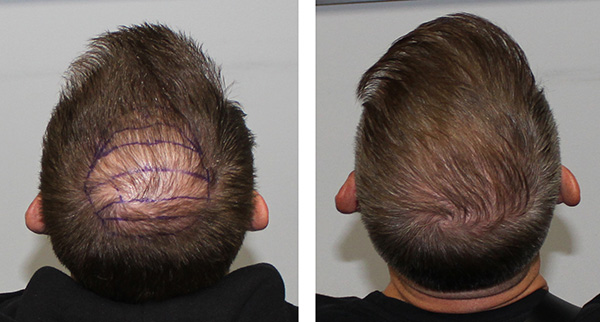Can hair transplant be done in the Crown

Let’s examine the crown, discuss hair loss in this area, explain the basic process of hair transplant surgery for the crown, what the results are like, and go over some common questions and concerns you might have, as well as the risks. Why? Because the more you know, the better your chances of getting what you want and need from your surgical hair restoration.
The Anatomy of the Crown
The crown is the area of the scalp at the top rear of your head, also known as the “vertex”; hair usually growing in a whirling pattern that spirals outwards from a central point, a single whirl, or even multiple whirls.
Because it has a spherical shape, and because hair grows in a swirl, the crown has long been widely regarded at the most challenging area in hair restoration surgery to achieve a natural appearance, because of this natural swirl a higher surgical skill for hair restoration is required to provide the natural-looking results patients hope to achieve.
Crown Hair Loss Patterns
Hair loss from the crown is generally associated with a pattern in which a bald area, gradually expanding around the crown, results in thinning hair. Androgenetic alopecia (male pattern hair loss or female pattern hair loss) often results in thinning hair in the affected areas. Some patients can experience hair loss at the hairline or temples, while in other patients hair loss at the crown begins with significant thinning or loss of hair without preliminary thinning of the frontal scalp.
For men with Norwood stages III through VII this thinning is accompanied by diffuse crown hair loss, but it is the crown area that undergoes rapid thinning. A similar pattern is seen in women, who also exhibit diffuse thinning over the scalp more generally, which can involve the crown.
Why Is the Crown More Difficult to Treat?
Crown Whorl/Swirl Pattern: Hair in the crown will grow at multiple angles because of the ‘whirl’ (how it grows out of the under layer of the skin). As well as coming in at the correct crown angle, the hair in a transplant may well come out at multiple angles. Very tricky technical work is required to obtain the correct natural-looking results.
Size of the Crown: Your crown area covers a greater surface area, so you’ll need more donor hair for the same look. If donor hair is a problem, your surgeon will have to balance the crown with the hairline and other scalp areas.
Natural density Essentially impossible. The crown tends to need far more grafts than any other part of the scalp.
Is a Hair Transplant Suitable for the Crown?
Yes, hair transplant surgery on the crown of the head is possible. But on the crown there are certain abnormalities, which your surgeon and you, must be aware of.
Candidacy for a Crown Hair Transplant
Not everyone is a candidate for hair transplant surgery. A potential patient must first be thoroughly evaluated and the donor area must be assessed for viability.
Duration of Hair Loss: Has the hair been gone a long time? If the hair loss is relatively new, the surgeon will likely want you to start taking medications that stimulate hair regrowth, but if the hair loss has already been present for anywhere from years to a decade or two, then a transplant might be the answer.
Pattern: At what stage of hair loss are you? If hair loss will continue, the surgeon will advise you to wait until your hair loss has stabilized before you pursuit a hair transplant procedure.
Extent of loss: Surgeon will decide how much loss there is (in the crown). Surgical transplant works well for moderate to severe hair-loss, but more common pattern is hair thinning all over the head or a increasing part or both, which typically respond better to a hair-growth medication wen it comes to women. Minimal thinning might be best served by watching to see if the loss stabilizes in a year or two.
Age: Young patients with early onset alopecia are not really good candidates if their balding is ongoing where the crown will continue to lose hair in the future.
Donor Areas: The patient must have sufficient hair at the back and sides of the head for a crown transplant – the ‘donor area’. If the hair stops short at the sides, the grafted hair can be incorporated into transitional hairlines, but filling the crown area will usually need more grafts, that is, more hair transplant work. If there’s not enough ‘donor area’, the hair must be used in other parts of the crown, where the contours are more restricted. However, that restricted hairline needs a ‘cut-in’ period before it’ll be usable or at all natural.
Hair Characteristics: Of course, the caliber and curl of the patient’s hair will have a major impact on the ultimate result. Those with fine straight hair will not achieve the same degree of crown thickening as those with thick hair or natural curl.
Advantages of Crown Hair Transplants
There are several advantages to undergoing a hair transplant in the crown:
After-effects: Over a period of time, when the transplanted hair at the back of the head has stabilized (after three-four months), the hair root grows again and the transplanted hair continues to grow for a lifetime.
Techniques for Crown Hair Transplants
There are two main techniques – Follicular Unit Transplantation (FUT) also known as strip harvesting and Follicular Unit Extraction (FUE). Both of them have their pros and they can be used to achieve a good hair restoration in crown region.
Follicular Unit Transplantation (FUT)
In the FUT method (‘strip method’) a strip of scalp tissue is taken from a donor area (this can be the back of the head). The strip will be used to extract individual hair follicles that can in turn be transplanted within the recipient area (the crown).
Benefits of FUT for Crown Transplants:
More Grafts From One Session (Mega-Session): FUT typically translates into more grafts per session, which can be quite useful if you are looking to transplant a large area such as a crown.
Increased Harvest Yield: As FUT provides more grafts per session, it is often a better option for patients with a significant level of hair loss at the crown who require substantial coverage.
Drawbacks of FUT:
Linear Scar: A straight-line scar will be left in a donor area and, depending on a patient’s choice, it could be seen potentially if he wear his hair very short; however, it is commonly hidden by longer hair.
Longer Recovery Time: FUT involves sutures and a longer recovery period compared to FUE.
Follicular Unit Extraction (FUE)
During Follicular Unit Extraction (FUE) procedures, each follicular unit is harvested as an individual unit using a small punch device, and is then placed in the receiver area.
Benefits of FUE for Crown Transplants:
Minimal Scarring: FUE leaves tiny, dot-scale scars that are easy to hide, perfect for those fellows that shave their hair close to the skin.
Quicker Recuperation: Since FUE doesn’t involve the surgical removal of a strip of skin, recuperation time is quicker than with FUT.
Drawbacks of FUE:
Lower Yield of Grafts: Since less hair follicles can be retrieved in one sitting with FUE this can be seen as a disadvantage if you require a larger harvest area in a single session.
More Involved: Since each follicular unit is harvested separately, you can anticipate an FUE procedure to take many times longer than a FUT procedure.
Choosing the Right Technique
Whether FUT or FUE will be better for a crown transplant will depend on both how many hairs are needed (which of course depends on the size of the balding area to be covered) and on how much donor hair is available, also it will also depend on the patient’s own preference for having a scar (and thus a quicker recovery time using FUE). In some cases, a crown will have to incorporate a combination of the two techniques.
What to Expect from a Crown Hair Transplant
Accurately knowing the estimated time for the course of treatment in a crown hair transplant such as the pre-operation preparation, operation itself and the recovery phase is important for patients who prefer to do some research ahead of time to prepare themselves and their families.
Consultation
The first step is an appointment with a hair transplant surgeon, which involves evaluating the patient’s degree of hair loss, the quality (or characteristics) of the donor area, and goals that the patient wishes to achieve. The hair transplant surgeon should also be able to provide advice and guidance on medical treatment options for patients, including finasteride and/or minoxidil to slow down the progression of hair loss well before and after the transplant.
Procedure
Utilizing the FUT, FUE, or a combination of both the surgeon will harvest hair follicles needed to complete the procedure. Once the surgeon harvests the grafts, he will commence with tiny incisions placed into the skin, that will be used to place places the graft into with the correct angle and direction so that the hair will look natural. It can take several hours to complete, depending on the size of the area being transplanted and the number of grafts needed.
Recovery
You should anticipate the donor and recipient areas to become traumatized, swollen, and ache; this resolves in a day or two and most patients are able to return to normal activities within a week but shouldn’t do anything strenuous for at least two weeks.
Hair Growth Timeline
Hair growth in the crown after a transplant follows a predictable timeline:
Weeks 1-3: The transplanted hairs may fall out in the donor area. This is a normal.
Months 3-6: Hair mostly comes in, though it’s usually thin and pale for a while.
Months 6-12: Regrown hair is thicker and more noticeable, with improved coverage overall.
Months 12-18: You should aim to see final results at 12-18 months, with full thickness and density being the goal.
Risks and Considerations
When it comes to hair transplants in the crown area of the head, the procedure is quite safe, although a number of risks and concerns should be considered. Razor bumps are one of the most common adverse effects associated with certain hair transplant scars, is the formation of small but numerous infections called pseudo facial hair folliculitis, commonly known as razor bumps.
Donor Shock Loss: (Temporary Hair Loss In Donor Area) This temporary hair loss of the donor area is almost always expected, as this loss is due to the trauma of the procedure and often resolves by itself within a few weeks.
Unnatural whirl: Hair in the crown regrows in another direction, if not done properly the surgery will leave your hair growing in directions that are not consistent with the surrounding hair, resulting in an unnatural look.
Ongoing hair loss: If hair loss continues, additional procedures may be required to maintain results.
Scarring: both FUT and FUE produce some scarring; however, FUE scars are far less conspicuous.
A hair transplant can work very well for the crown – as long as you go to an experienced transplant surgeon, one who knows the nuances of making this area look natural (not always a given).





